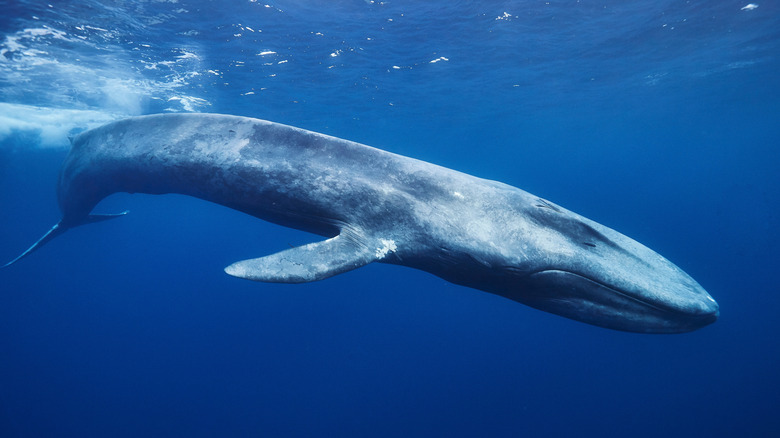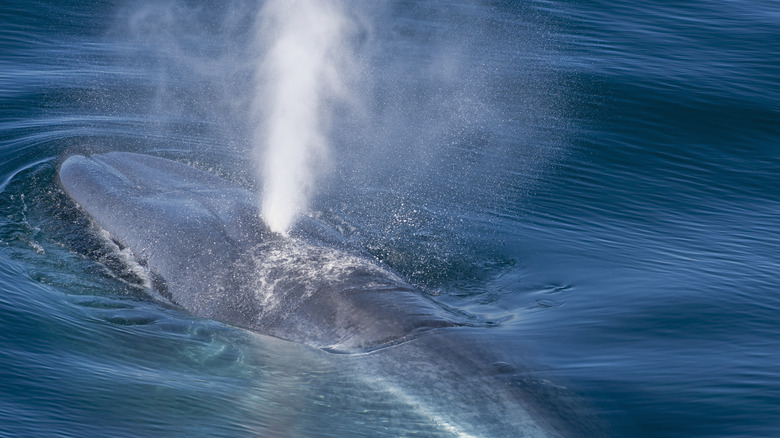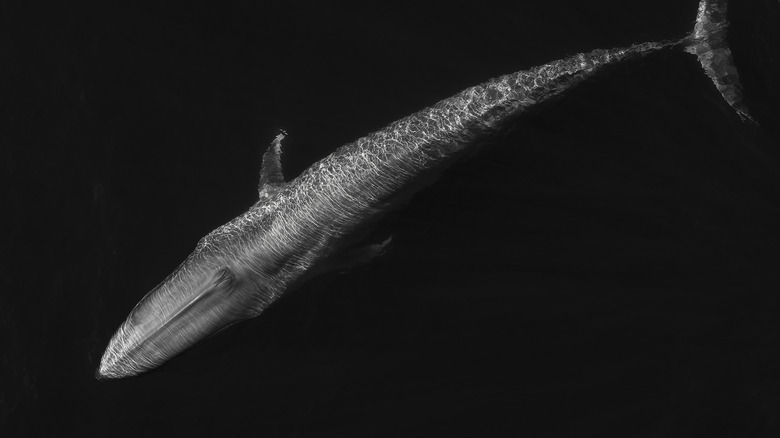The Largest Whale In The World Weighs More Than Thousands Of People Combined
The blue whale is famously the largest animal in the world, but this simple fact doesn't do these creatures justice. They aren't just the biggest animals in the world today, but the biggest known to have ever existed. The average length of a blue whale is about 90 feet, almost as long as a basketball court, and they weigh an average of 300,000 pounds. That's about 150 times the weight of a bison, the largest land mammal in America. Their offspring, the largest babies in the animal kingdom, weigh as much as an African elephant. But these are just the averages; the biggest blue whales on record are even more extreme.
The heaviest blue whale ever recorded was a victim of whaling, caught in Antarctic waters in 1947. She weighed a whopping 418,878 pounds, which is about the weight of 2,500 average adult humans. The longest blue whale on record was also a female killed by whalers, this time in the South Atlantic Ocean in 1909. She was just over 110 feet long. Those two individuals stand as the largest animal specimens ever known to humankind, but they also beg a very important question: what's the point of all that body mass?
The advantages of a blue whale's size
Being the largest animals to have ever lived provides some significant advantages to blue whales. Aside from humans, they only have one natural predator: the orca. Bigger animals also have more efficient metabolisms, which allows blue whales to build up huge stores of fat that can reach as much as half of their total body mass. That fat provides a steady source of energy for the whales, so they can bulk up during the summer feeding season and then use the stored fuel to swim to their breeding grounds, without needing to stop frequently for food.
The diet of each whale species is closely related to their size. Blue whales are examples of baleen whales, filter feeders who use jaws full of brush-like bristles to separate prey from the ocean water. Blue whales exclusively feed on krill, a food source that is abundant in the ocean but also in very high demand. In order to compete with other species for this precious food, it helps to have a massive mouth. Blue whales are the world champions in this regard, capable of consuming over 450,000 calories in a single mouthful.
Achieving a body mass like that of a blue whale wouldn't be possible for any terrestrial animal. One of the main reasons blue whales are able to get so big is that the water they live in supports their bulk. If a land animal were to reach 400,000 pounds, it would collapse under its own weight.
Blue whales keep getting bigger ... for now
Millions of years ago, the ancestors of today's blue whales were significantly smaller, but around the end of the Miocene epoch, 5.3 million years ago, they began to experience dramatic growth. This likely resulted from an increase in available food: As the cooler Pleistocene epoch got underway, glaciers released nutrient-rich sediments into the oceans, leading to a boom in marine life. Ever since, blue whales have been steadily growing in size, and that process is still happening to this day. The primary blue whale feeding waters around Antarctica experience significant upwellings of deep water currents, which carry krill to the upper levels of the ocean where whales can feast. The continued abundance of this food supply has allowed blue whales to steadily increase in size over millions of generations.
However, the blue whale's period of growth may be nearing its end. The key to the creatures' massive size is their ability to consume massive quantities of food, but this is a double-edged sword, as a larger body also requires more food to sustain. Thus, the size of blue whales is mostly dependent on food availability, something that is currently threatened by climate change. Warmer waters and an increase in ocean acidity have dealt a blow to the krill population, and if the whales' food source dwindles, so will they. This is especially concerning, as blue whales are currently listed as an endangered species.


